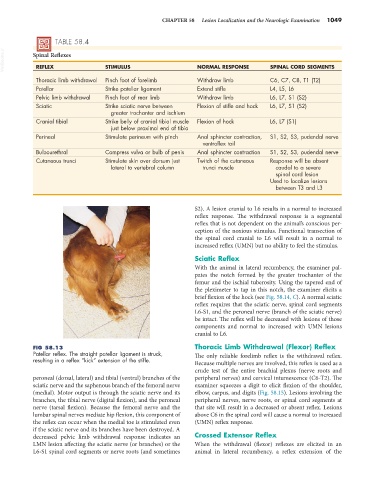Page 1077 - Small Animal Internal Medicine, 6th Edition
P. 1077
CHAPTER 58 Lesion Localization and the Neurologic Examination 1049
TABLE 58.4
VetBooks.ir Spinal Reflexes STIMULUS NORMAL RESPONSE SPINAL CORD SEGMENTS
REFLEX
Thoracic limb withdrawal Pinch foot of forelimb Withdraw limb C6, C7, C8, T1 (T2)
Patellar Strike patellar ligament Extend stifle L4, L5, L6
Pelvic limb withdrawal Pinch foot of rear limb Withdraw limb L6, L7, S1 (S2)
Sciatic Strike sciatic nerve between Flexion of stifle and hock L6, L7, S1 (S2)
greater trochanter and ischium
Cranial tibial Strike belly of cranial tibial muscle Flexion of hock L6, L7 (S1)
just below proximal end of tibia
Perineal Stimulate perineum with pinch Anal sphincter contraction, S1, S2, S3, pudendal nerve
ventroflex tail
Bulbourethral Compress vulva or bulb of penis Anal sphincter contraction S1, S2, S3, pudendal nerve
Cutaneous trunci Stimulate skin over dorsum just Twitch of the cutaneous Response will be absent
lateral to vertebral column trunci muscle caudal to a severe
spinal cord lesion
Used to localize lesions
between T3 and L3
S2). A lesion cranial to L6 results in a normal to increased
reflex response. The withdrawal response is a segmental
reflex that is not dependent on the animal’s conscious per-
ception of the noxious stimulus. Functional transection of
the spinal cord cranial to L6 will result in a normal to
increased reflex (UMN) but no ability to feel the stimulus.
Sciatic Reflex
With the animal in lateral recumbency, the examiner pal-
pates the notch formed by the greater trochanter of the
femur and the ischial tuberosity. Using the tapered end of
the pleximeter to tap in this notch, the examiner elicits a
brief flexion of the hock (see Fig. 58.14, C). A normal sciatic
reflex requires that the sciatic nerve, spinal cord segments
L6-S1, and the peroneal nerve (branch of the sciatic nerve)
be intact. The reflex will be decreased with lesions of those
components and normal to increased with UMN lesions
cranial to L6.
FIG 58.13 Thoracic Limb Withdrawal (Flexor) Reflex
Patellar reflex. The straight patellar ligament is struck, The only reliable forelimb reflex is the withdrawal reflex.
resulting in a reflex “kick” extension of the stifle. Because multiple nerves are involved, this reflex is used as a
crude test of the entire brachial plexus (nerve roots and
peroneal (dorsal, lateral) and tibial (ventral) branches of the peripheral nerves) and cervical intumescence (C6-T2). The
sciatic nerve and the saphenous branch of the femoral nerve examiner squeezes a digit to elicit flexion of the shoulder,
(medial). Motor output is through the sciatic nerve and its elbow, carpus, and digits (Fig. 58.15). Lesions involving the
branches, the tibial nerve (digital flexion), and the peroneal peripheral nerves, nerve roots, or spinal cord segments at
nerve (tarsal flexion). Because the femoral nerve and the that site will result in a decreased or absent reflex. Lesions
lumbar spinal nerves mediate hip flexion, this component of above C6 in the spinal cord will cause a normal to increased
the reflex can occur when the medial toe is stimulated even (UMN) reflex response.
if the sciatic nerve and its branches have been destroyed. A
decreased pelvic limb withdrawal response indicates an Crossed Extensor Reflex
LMN lesion affecting the sciatic nerve (or branches) or the When the withdrawal (flexor) reflexes are elicited in an
L6-S1 spinal cord segments or nerve roots (and sometimes animal in lateral recumbency, a reflex extension of the

